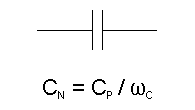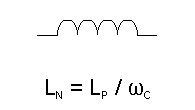A change in the corner frequency requires that the impedances of each inductor and capacitor be changed from the prototype's values by a factor equal to the change in frequency. The factor is

Conceptually, an adjustment to the reactances of the capacitors and inductors is needed so that the reactances remain the same when the new frequency is applied. Since 1 rad/sec is a very low frequency, most of the time this will involve making the inductors and capacitors smaller. Division is conceptually sound. But even if the frequency were less than 1 rad/sec, a division by a number less than one increases the reactances. This notion is intuitively correct, also.







